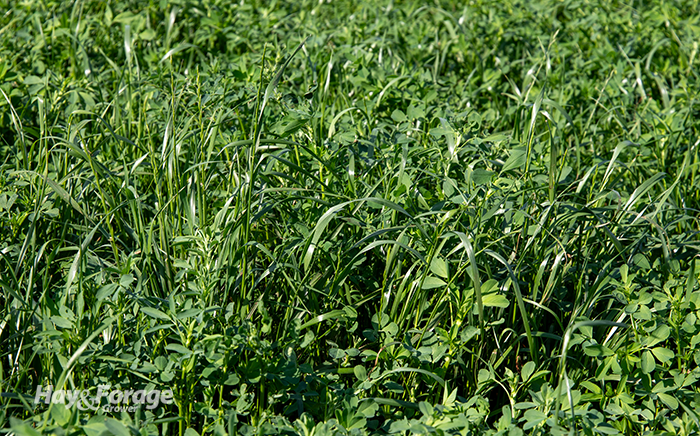
Alfalfa typically hits its peak two or three years after it is established before annual forage yields start to decline. One way to give an aging stand a boost and extend its productive life is to add grass to it. But some grass species may be better suited for interseeding into alfalfa than others.
In a recent Farm Report from the Miner Institute, Ev Thomas, a retired forage agronomist, describes how different grass species perform in mixed stands. He recommends assessing a stand’s composition to determine whether it is time to terminate the mixed stand or if yields will be sufficient for another growing season.
According to Thomas, when timothy is interseeded into alfalfa, there will likely be less grass harvested with second, third, and fourth cuttings compared to the first. “Timothy often becomes dormant as soil temperatures rise, even with plenty of rain,” he writes.
For this reason, he advises against opting for this mix unless farmers have specifically established a market for it — usually to horse owners. In general, he contends timothy is a poor fit for interseeding into alfalfa.
Tall fescue and meadow fescue, on the other hand, are more likely to consistently show up in higher volumes throughout the harvest season. Where farmers seeded these grasses into stands to improve total forage yields, Thomas suggests taking stock of how much alfalfa is present.
“If the alfalfa is thin, you might want to rotate it to another crop next year,” he writes. If the stand still has some potential, he recommends topdressing manure as soon as possible after the next hay harvest.
Orchardgrass seeded into alfalfa can also provide sufficient regrowth for subsequent cuttings — as long as there is enough soil moisture. However, Thomas cautions that orchardgrass quality is quick to decline after seedheads emerge. Selecting and seeding late-maturing varieties may be one solution.
Avoid clover and alfalfa
As far as other options go, Thomas advises against drilling red clover into an alfalfa stand. “Between a lack of moisture and competition from the regrowing crop, forage seedlings will have a tough time competing with the established plants around them,” he explains.
Drilling alfalfa into alfalfa is also not an option to thicken thinning stands because of the risk of autotoxicity. Although the mechanisms behind alfalfa autotoxicity remain somewhat of a mystery, it can cause autoconditioning or autosuppression, which is the permanent damaging of seedling root systems that inhibits mature plants from reaching their full potential. Autotoxicity ultimately prevents farmers from reseeding alfalfa into an existing or recently terminated stand without a rotation crop in between.
Research led by Kim Cassida at Michigan State University suggests there may be a connection between poor soil fertility and alfalfa autotoxicity, with mature plants producing and releasing root exudates into the soil to compensate for nutrient deficiencies. The hypothesis is that these root exudates negatively impact young alfalfa seedlings.
Overall, different species will support different production goals for stands in different regions. Regardless of the mix, monitor forage composition to assess alfalfa-grass performance and determine when it is time to terminate the stand and move on to the next crop in the rotation.

